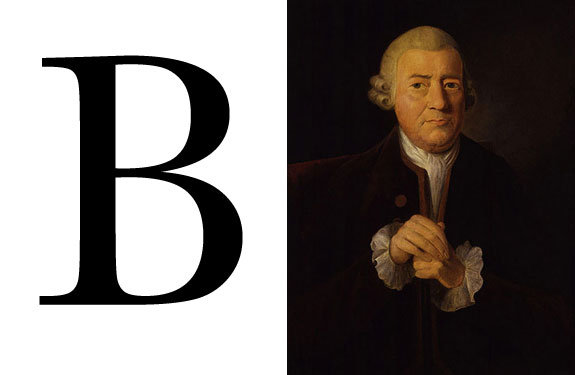January 28
On this day in 1706 John Baskerville was baptized. He thus began life with a blessing, although he ended as a Free Thinker and—in the opinion of many of his contemporaries—an atheist. Honored now for his reputation as a great printer and as the designer of one of the universal typefaces, Baskerville’s personal life is not much remembered. In actuality, he was probably not an atheist but merely rebellious against some of the practices of the established church. He had, after all, printed a notable bible, an edition of the Book of Common Prayer, and editions of the Psalms. His eccentricities, however, were legion, and they were continued in the writing of his will.
When friends asked him how he wished to be buried, Baskerville is reputed to have answered that they could “bury him sitting, standing, or lying, but he did not think they could bury him flying.” Upon his death he was buried in a vault in a conical building on his own property of Easy Hill. He wrote his own epitaph, as follows:
Stranger—
Beneath this cone in unconscrated ground
A friend to the liberties of mankind
Directed his body to be inhum’d
May the example contribute to
emancipate thy mind
From the idle fears of superstition
And the wicked arts of priesthood.
In the short, informative biography written in 1914 by Josiah Henry Benton, the author describes the macabre events which followed:
“When Baskerville House was sold to a Mr. Reyland in 1789, the owner did not disturb the body and it remained for nearly fifty years in comparative peace. During the Birmingham riots of 1791, Baskerville House was stormed, sacked, gutted, and burned. It was not, however, until alterations were made on the property that Baskerville’s coffin was removed, and taken to a warehouse, where it remained for some time subject to visits from the curious, and even to scientific observations on the condition of the body. Mr. Ryland, ascertaining that a show was made of the remains, insisted that they should be suitably interred, and Mr. Marston, in whose shop the coffin had been placed, applied to the rector of St. Philip’s for permission to bury the body there. This was refused on account of Baskerville’s atheism, when Mr. Knott, the bookseller, said that he had a vault in Christ’s Church, and should consider it an honor to have Baskerville’s remains rest there, and they were there placed about 1829.
“Even here Baskerville’s body did not rest permanently, for the necessary extension of Birmingham caused Christ’s Church to be demolished, and his remains, which should have been placed in St. Philip’s Church by the side of his wife, being again refused interment there by the rector, were placed in one of the catacombs of the Church of England Cemetery at Warnstone Lane. And so, finally, after being turned out of the garden at Easy Hill for a canal wharf, exposed to neglect and ignominy in a plumber’s warehouse, interred by stealth in the vault of Christ’s Church, and then again removed by the march of business, Baskerville’s bones at last found permanent rest in a quiet cemetery of the Church of England.”
